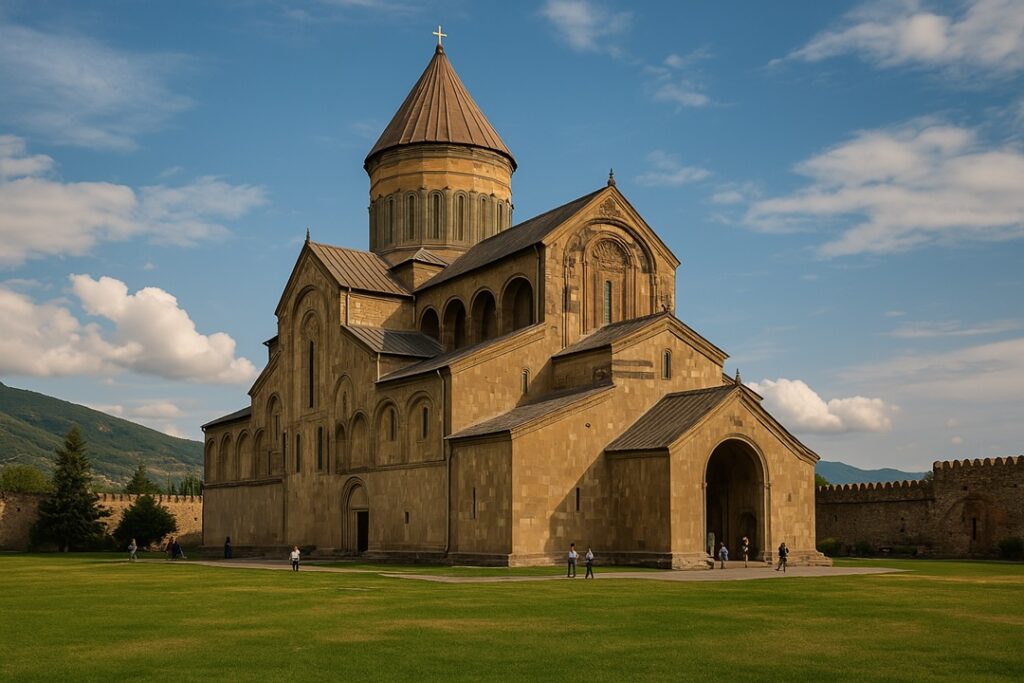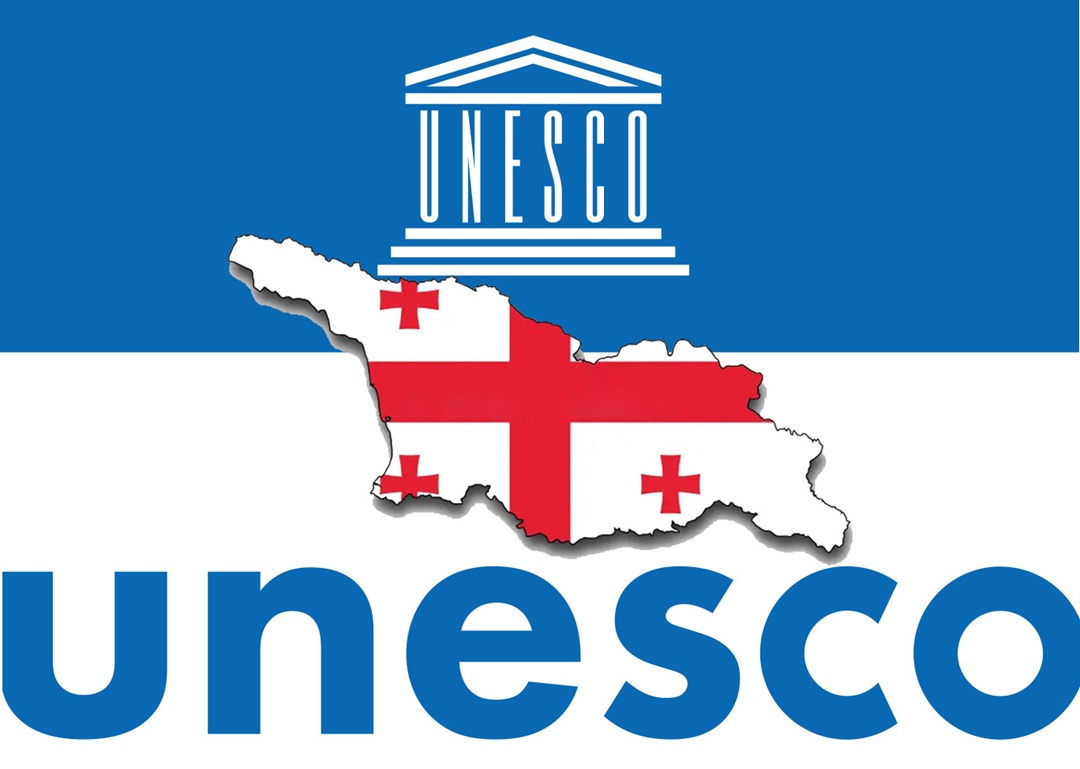By the Auto Journey Mapper Team
Georgia isn’t just some country with a few old buildings marked on a map — it’s a living, breathing story. The second you cross the border, it feels like stepping onto a massive open-air stage where the mountains whisper prompts and ancient stones murmur secrets into your ear. Every twist in the road feels like a chapter from a saga that started way before Columbus even dreamed of a boat. One moment, you’re cruising past a fortress that predates half of European history, the next — a vineyard whose roots go back to Roman legions.
You’re not just sightseeing — you’re stepping into an epic where monasteries guard the remains of saints and cave towns look like movie sets from a medieval fantasy flick. Even the wind here feels ancient — carrying the scents of mountain honey, spices like khmeli-suneli, and maybe even a whiff of old parchment hidden deep in monastery cellars.
But the real magic of Georgia? The people. Strangers greet you like family, offering homemade chacha in recycled bottles and spinning wild tales that blur the line between legend and lived truth. This country’s like a hand-woven tapestry, where every thread tells a story — of love, war, secrets, and survival.
And your car? It’s not just a vehicle. It’s your key to unlocking treasure chests hidden behind every mountain pass.
Svetitskhoveli Cathedral (Mtskheta)

UNESCO Since: 1994
History That Smells Like a Legend:
According to local lore, this is where the robe of Jesus ended up — brought here by an Ethiopian queen. The 11th-century cathedral isn’t just a stunning piece of architecture; it’s a symbol of Georgian unity. When the Persians invaded in the 1600s, this place stood strong — hiding its relics beneath the floor. Fun fact: Russian Prince Alexander Nevsky got married here, because Russian royals considered Mtskheta sacred ground.
Getting There:
It’s just a 30-minute drive north of Tbilisi — rent a car with Getmancar or compare prices on Rentalcars. But don’t rush. Stop at the Aragvi bridge along the way — they shot scenes from the movie Mimino here. Right nearby, check out the old inn “Salobia” — their lamb khashlama is pure comfort in a bowl.
Editor’s Tip:
Catch the morning service — the choir alone will give you chills. Afterward, swing by a local shop and grab some handmade churchkhela (the candy-on-a-string thing that looks like candle wax but tastes like heaven).
Where to Stay:
Guesthouses with cathedral views are all over Mtskheta. “Anana Urbnisi” is a favorite — the host knows where to find a spring rumored to have “living water.”
Jvari Monastery (Mtskheta)

UNESCO Since: 1994
Where Georgia Was Born:
Back in the 4th century, Saint Nino planted a cross here and introduced Christianity to Georgia. The 6th-century monastery stands boldly on a cliff, watching over the spot where two rivers — Aragvi and Kura — meet. Its cross-in-square design set the blueprint for Georgian churches that came after. Movie trivia: scenes from From Dawn Till Dawn (no, not the Tarantino one) were shot here — look for the carved stone slab that played “the altar.”
Getting There:
It’s a short 10-minute drive from Mtskheta. If you rent a car with a panoramic roof, the views along the winding road are unforgettable. Make a pit stop in Tsromi village — they’ve been baking khachapuri with saffron since the 13th century.
Life Hack:
Ditch the car and hike up — there are ancient rock carvings hidden along the trail. On the way back to Tbilisi, take the scenic route through Samtavro village and grab some monastery-made honey.
Gelati Monastery (Kutaisi)

UNESCO Since: 1994 (expanded in 2017)
A University Older Than Oxford:
Built in 1106 by King David the Builder (coolest title ever?), Gelati was once known as “the second Jerusalem.” They’ve got astronomical maps showing Earth as a sphere — drawn centuries before Copernicus showed up. The monks? Still brewing mead in the basement from 12th-century recipes. There’s even a story about Queen Tamar sneaking off here to meet her secret Alan prince.
Getting There:
10 km from Kutaisi — drive through the dreamy Rioni Valley. If you rent through Getmancar, ask for a Russian audio guide — they’re free. Don’t skip the tiny, fierce Gelati waterfall on the way — it’s a heartbeat of the mountains.
Watch Out:
The road gets narrow near the monastery — no risky overtakes. Afterward, pop into “Tsiskari” cafe — their kuchmachi (offal stew) is famous for a reason.
Vardzia Cave City

UNESCO Since: 1994
Queen Tamar’s Underground Maze:
Back in the 13th century, people were literally hiding from Mongol invasions in this place. Today, what’s left is a mind-blowing complex of 600+ caves, all connected by narrow tunnels. It’s like a real-life fantasy RPG level. One cave even had a wine barrel dated 1578 — because, of course, Georgians made wine even in underground hideouts. Fun side note: they shot scenes from the TV series Klinika here — look for the cave with a “hospital bed” carved from stone.
Getting There:
It’s about 260 km from Tbilisi — 3.5 hours by car. You’ll want a 4×4 for the last stretch, which is all dirt road. On the way, stop by Borjomi — fill a bottle straight from the spring and grab some Borjomi in glass bottles as souvenirs (locals say it’s basically bottled love).
Pro Tip:
Bring a flashlight. Deep inside the caves it gets pitch black, and you’ll find charcoal wall drawings if you look close. Stay overnight at the cozy “Vardzia Garden” guesthouse — the host will teach you how to make mchadi (those slightly crispy cornmeal flatbreads) in the morning.
Svan Towers (Ushguli)

UNESCO Since: 1996
Medieval Skyscrapers:
These 20-meter towers were built without a single nail — each family had their own “fortress.” The bottom level was for livestock, the top was for defending against invaders. Total DIY castle life. Also, scenes from the haunting Soviet film Repentance were filmed here — you can visit a little museum packed with original props.
Getting There:
45 km from Mestia, but don’t let the number fool you — this is a serious mountain road. You’ll need a 4×4 with snow chains if it’s even slightly off-season. Getmancar’s got you covered. Make pit stops at the dozen waterfalls along the way — each one’s got its own vibe. Pro tip: the “Makhuntseti” waterfall has a natural ice bath if you’re feeling brave.
Heads-Up:
Roads are closed in winter — plan your trip between June and September. In Ushguli, treat yourself to a night in a tower-turned-guesthouse like “Lamaria.” Sleeping inside ancient stone walls? Unreal.
Regional Eats — What to Try (and Where)
Mtskheta & Kakheti:
- White wine from Tsinandali
- Chakapuli (slow-cooked lamb with herbs that smell like spring)
Svaneti:
- Kubdari (meat pie with spices and sometimes cheese)
- Ushtebauri (cheese baked in dough, dangerously addictive)
Imereti:
- Imeretian khachapuri (oozy cheese bomb of a bread)
- Qvevri wine (fermented in clay pots — earthy and wild)
A Few Vibes by Region
Kakheti: Rolling vineyards, mountain meadows, and old-school hospitality that feels like it belongs in a novel.
Svaneti: Wild trails, ancient watchtowers, and fog so thick it tells stories.
Imereti: Lush valleys, caves where Prometheus was (allegedly) chained, and thick walnuty ajika (hot sauce with soul).
The Goodbye That’s Not Really Goodbye
When you get back home, Georgia doesn’t stay behind. It lingers — in the form of something unshakable. Like the memory of a sunset over the towers of Ushguli, or the sound of wind echoing through Gelati’s arches. It’s the kind of place that roots itself in you. The wine, like its stories, only deepens over time.
You’ll catch yourself saying “I’ll go back someday” — but it won’t sound casual anymore. It’ll sound like a promise. Because by now, you know: here, every road doesn’t just lead to a site — it leads to another chapter in your own story.
And next time you get behind the wheel, maybe you won’t even need GPS. You’ll just hum that Georgian monk song from Svetitskhoveli, and let the road sing back.
So — until next time, out there on the roads that smell like freedom, with a piece of churchkhela stuck to your map like a reminder: You were never a stranger here.
As of the time of publication, all the cultural and historical sites listed here are either protected by UNESCO or have been nominated for inclusion.
